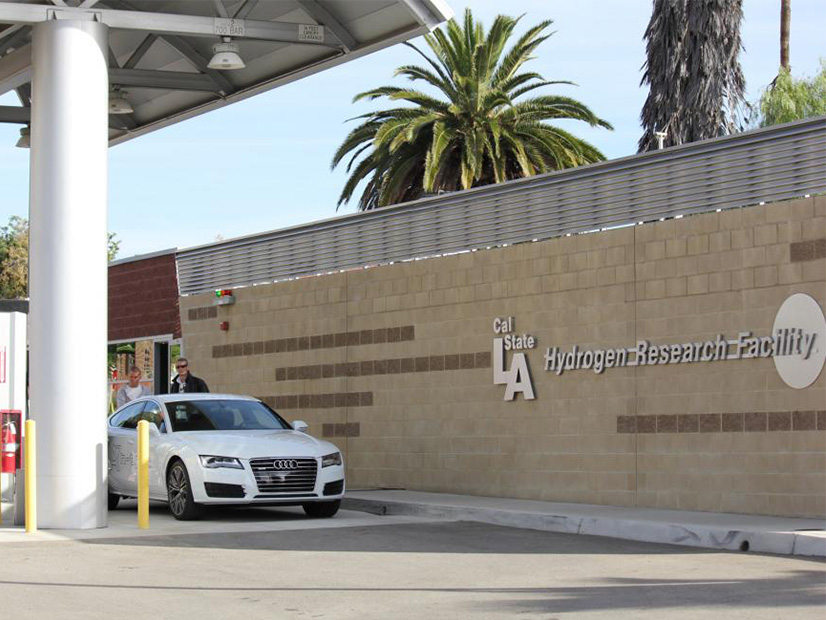Green hydrogen is one potential piece of California’s efforts to reach carbon neutrality by 2045, but the state is just getting started on evaluating the energy source, a member of the state’s Public Utilities Commission said during a conference this week.
“California is at an early state in examining how green hydrogen could fit into this long-term energy mix,” CPUC Commissioner Darcie Houck said Monday during the virtual annual meeting of the Western Conference of Public Service Commissioners (WCPSC). “And with the right technology in place, hydrogen has the potential to provide one option for long-term energy storage that could be a part of California’s toolkit to cut … carbon emissions by 2045.”
Houck was one of the panelists in a conference session on hydrogen.
So-called green hydrogen is produced through an electrolytic process in which water is split into its components, hydrogen and oxygen. The resulting hydrogen is considered green if the electrolysis was powered by renewable energy.
Houck said that one factor leading to California’s exploration of green hydrogen was Senate Bill 1369 by Sen. Nancy Skinner (D), adopted in 2018.
The bill instructs the CPUC, the California Air Resources Board (CARB) and the California Energy Commission (CEC) to consider green hydrogen as an eligible form of energy storage and contemplate other potential uses of green hydrogen.
A bill proposed by Skinner this session, SB 18, would take things a step further. It would require CARB to include a strategic plan for hydrogen as part of its Climate Change Scoping Plan. CARB is working on a 2022 update to the scoping plan, which will serve as a blueprint for how the state can achieve carbon neutrality by 2045.
SB18 would also require the CPUC to consider green hydrogen in resource adequacy requirements and energy storage proceedings. The Senate passed SB 18 last month on a 38-0 vote, and it’s now in Assembly committee.
Houck said the CPUC has committed to deploying 200 hydrogen fueling stations and also approved $24 million for the natural gas research and development program for fiscal year 2020/21. The research program is administered by the CEC.
A CPUC proceeding on biomethane has been expanded to examine the amount of renewable hydrogen that can be safely injected into the gas pipeline system, Houck said. The agency has brought in the University of California, Riverside, to conduct a study on hydrogen blending impacts. Results are expected in the fall.
‘Unique Variable’
The regulatory issues related to green hydrogen are not simple, Houck said. For example, questions around natural gas infrastructure need to be addressed.
“This question requires that we consider significant tradeoffs between reducing emissions, resource diversity and resiliency, and costs to customers, including stranded costs,” she said.
Blending hydrogen in the gas pipeline system could reduce the carbon intensity of gas but would require investment in and maintenance of natural gas infrastructure, Houck said. Another issue is that a growing number of California cities are banning natural gas hookups in new construction, she said.
Panelist Laura Nelson, vice president of Strategen and an advisor to the Green Hydrogen Coalition, noted that hydrogen is a globally traded commodity that’s used in industrial and manufacturing applications. But much of the hydrogen in use today is what’s considered “gray” or “brown” hydrogen, meaning it’s produced from natural gas or coal with a resultant carbon footprint.
“Green hydrogen, if we can scale it and produce it, then we can displace hydrogen that maybe has a much higher carbon intensity, carbon footprint, and really help to drive decarbonization of an already globally traded commodity,” Nelson said.
In addition, Nelson said, green hydrogen applications can potentially be expanded into sectors that have been difficult to decarbonize.
Oregon Public Utility Commissioner Mark Thompson, the panel moderator, explained why he is excited about hydrogen.
“I see some major trends, especially in the West, that point to the need for long-term, clean and reliable energy and energy storage,” Thompson said.
In addition, he said, there’s a need for dispatchable energy resources and making sure that renewable electricity resources are put to the best use.
“Hydrogen may represent a unique variable in solving that equation,” he said.




